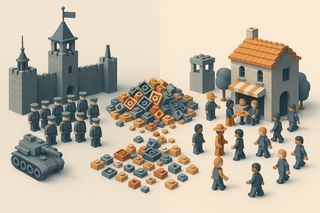Have you ever felt that familiar buzz from your pocket, reached for your phone, and found it silent and still? It wasn't a real notification, but the sensation was unmistakable. You have subconsciously waited for it, and it manifested itself in your reality. It was a phantom signal—a message generated entirely by your own brain, anticipating a connection. Or perhaps you've found yourself unlocking your phone, swiping through screens, and closing it again without a single conscious thought, almost as if your hand had a mind of its own.
It was a phantom signal—a message generated entirely by your own brain, anticipating a connection.
It's a strange, uniquely modern feeling. It's easy to brush it off as just a "bad habit" or a side effect of our "always-on" world. But what if it's something more? What if that twitchy, reflexive impulse isn't just a habit, but a sign of a much deeper connection—a system that has taken root, blurring the line between you and the technology you use?
Let's explore a different way to see this dynamic, not as a personal failing, but as a fundamental system at work.
The System Behind the Habit #
So, what's really happening when our brain manufactures a phantom buzz? It's a sign that two different systems are locking together.
On one side, you have the information systems in your phone. An app isn't just a passive tool; it's a system designed with a goal—to capture and hold your attention. It uses a sophisticated rulebook of notifications, rewards, and endless content to keep you engaged.
On the other side, you have us—the biological system. We invest immense resources into these apps: our time, our focus, and even our identity. Our photos, our conversations with loved ones, our professional networks—they all live inside these digital frameworks. Over time, we don't just use the app; we make it a part of who we are. Think of the fierce loyalty in the Apple vs. Android debate; we often defend our chosen device as if it were a part of our own identity.
And this pattern isn't just about technology. It's visible in a die-hard sports fan whose identity is fused with their team's story, in a political activist whose worldview is shaped by their movement's ideology, or in a corporate culture so strong that it dictates how its employees think and act. The underlying system is the same.
A Name for the Merger: The Bio-Informational Complex #
When this connection gets tight enough, the two systems—the biological and the informational—effectively merge. They begin to function as a single, higher-order unit with its own rules and behaviors. Your goals and the app's goals become intertwined.
This tightly coupled entity, this hybrid of human and information? Let's call it a Bio-Informational Complex (BIC).
It's a system where a person (bio) and the information they use (informational) become so deeply entangled that they function as a single whole.
This goes beyond simple groupthink; it's an active, co-evolutionary process where the information system itself helps build the host's defenses and identity. The information shapes the person, and the person embodies, defends, and spreads the information.
From Helpful to Harmful: Why BICs Matter #
These systems aren't just an interesting pattern; they have real-world consequences. A BIC can be powerfully beneficial, like when a group of scientists adopts the 'scientific method'—a set of informational rules—to collaborate and uncover new truths about the world.
However, they can also become parasitic, thriving by twisting a host's perception of reality and isolating them from outside contact. To understand how a harmful BIC operates, there is no better or more recent example than the sprawling online phenomenon known as QAnon.
Case Study: Anatomy of a Parasitic BIC - QAnon #
The Information System: An Alternate Reality Game #
At its heart, the QAnon information system was not a simple conspiracy theory; it was a participatory game. Its core components were the "Q drops"—a series of cryptic, breadcrumb-like posts from a supposed government insider.
This format was ingenious. The drops were rarely direct statements; they were a mix of questions, vague clues, and acronyms. This wasn't a bug, but a feature: it demanded interpretation. To understand, a person couldn't be a passive consumer of news; they had to become an active "digital soldier" doing their own "research," connecting dots, and collaborating with others to decode the messages. This active participation is a powerful mechanism for building belief.
Layered on top of this was a simple, epic narrative: a secret war between a heroic president and a global cabal of satanic pedophiles. This story provided a clear, emotionally charged framework of good versus evil. Finally, a unique vocabulary ("The Storm," "The Great Awakening," "WWG1WGA") and symbols acted as a social glue, creating a powerful in-group identity and a shared, secret knowledge that set its members apart from the unawakened masses. Together, these elements created a self-contained alternate reality, complete with its own logic, evidence, and trusted sources.
The Host: A System for Fulfilling Deep Human Needs #
An information system, no matter how clever, needs a receptive host. The QAnon BIC flourished because it acted as a near-perfect solution to several deeply felt human needs, especially in a time of social isolation and political uncertainty.
First, it offered community. For individuals feeling disconnected or alienated, QAnon provided an instant, passionate, and welcoming group. The shared mission and secret language created powerful social bonds, transforming lonely hours online into a collaborative quest for truth.
Second, it provided gamified purpose. Instead of being a powerless observer of confusing world events, the BIC transformed its followers into heroic protagonists. The process of "doing your own research" was a brilliant form of gamification. The "Q drops" were quest prompts; finding a connection between two disparate pieces of information provided a dopamine hit of discovery; learning the lore felt like leveling up. This turned passive information consumption into an addictive, interactive process that gave followers a powerful sense of agency.
Finally, it offered cognitive relief. The world is complex and frightening. Holding multiple, often contradictory, ideas in your head is mentally exhausting. The QAnon narrative offered an attractive bargain: in exchange for your belief, it would do the hard work of making sense of everything. It replaced chaos with a single, all-encompassing explanation, providing a clear hero, a clear enemy, and the promise of a triumphant ending. This outsourcing of cognitive load offered powerful psychological relief from the anxiety of uncertainty.
The Lifecycle in Action: From Curiosity to Capture #
So how does a person go from a casual observer to a captured host? The process follows a predictable lifecycle.
Phase 1 & 2: Exposure and Adoption #
No one starts by believing everything. It begins with a single video, a forwarded article, or a meme that raises an interesting question. Curiosity leads down the "research" rabbit hole. In this phase, the person is simply learning the language and core ideas. They start spending more time on specific forums and video channels, and the gamified "aha!" moments of connecting the dots provide powerful reinforcement.
Phase 3: Lock-In #
This is the critical turning point where the BIC's defenses activate on two levels.
On the individual level, the primary defense is cognitive dissonance. After investing so much time and identity, seeing a news report or hearing from a family member that directly contradicts the narrative creates intense psychological discomfort. To resolve this pain, the host can either admit they were wrong—risking their community and sense of purpose—or they can reject the contradictory information. The latter is a far easier path.
The resulting social punishment is a collective lashing-out, designed to destroy the source of that shared psychological pain.
On the collective level, the social group immediately weaponizes this individual discomfort. The BIC's community acts as a powerful self-stabilization mechanism because an external challenge forces every member to feel that same spike of cognitive dissonance. The resulting social punishment (labeling dissenters as "shills" or "deep state agents") is a collective lashing-out, designed to destroy the source of that shared psychological pain.
Phase 4: Propagation #
Once locked in, the host feels a moral obligation to "wake up" others. They become an active vector for the BIC, sharing content across social media, trying to convert friends and family, and recruiting new hosts into the alternate reality. They are no longer just a believer; they are an evangelist.
Phase 5: Drift and Breakdown #
When major predictions fail (like a promised event not happening), the BIC doesn't always collapse. Some hosts will "drift," working with the community to reinterpret the failure as a more complex part of the plan ("disinformation is necessary"). For others, however, this can be the shock that finally breaks the lock-in, leading to a painful and disorienting breakdown of their constructed reality.
Seeing the System #
So the next time you feel that phantom buzz, recognize it for what it is: the smallest echo of a much larger pattern. Whether it's the fierce loyalty of a sports fan, the personal connection to your phone, or the all-encompassing reality of a political movement, the underlying system is the same. The intensity and outcomes differ dramatically, but the mechanics—the lock-in of identity, the promise of community, the protective reactions—are a universal pattern.
The Bio-Informational Complex isn't just a theory; it's a lens. It reveals the hidden architecture behind the systems that compete for our attention and belief. The goal isn't to escape all BICs—many, like the scientific method, are vital and beneficial. The goal is to see them clearly. By understanding the rules of the game, we become better equipped to choose which systems we serve, to recognize when they become harmful, and to understand the real price of our attention.
Interested in more detail? #
If you are interested in more detail on the concept of BIC, either from a scholarly point of view, or just general curiosity, feel free to check the operationalized document on BICs, complete with identifying characteristics, functional spectrum, comparative analyses, hypotheses, revision conditions and other fun lower altitude bits.



